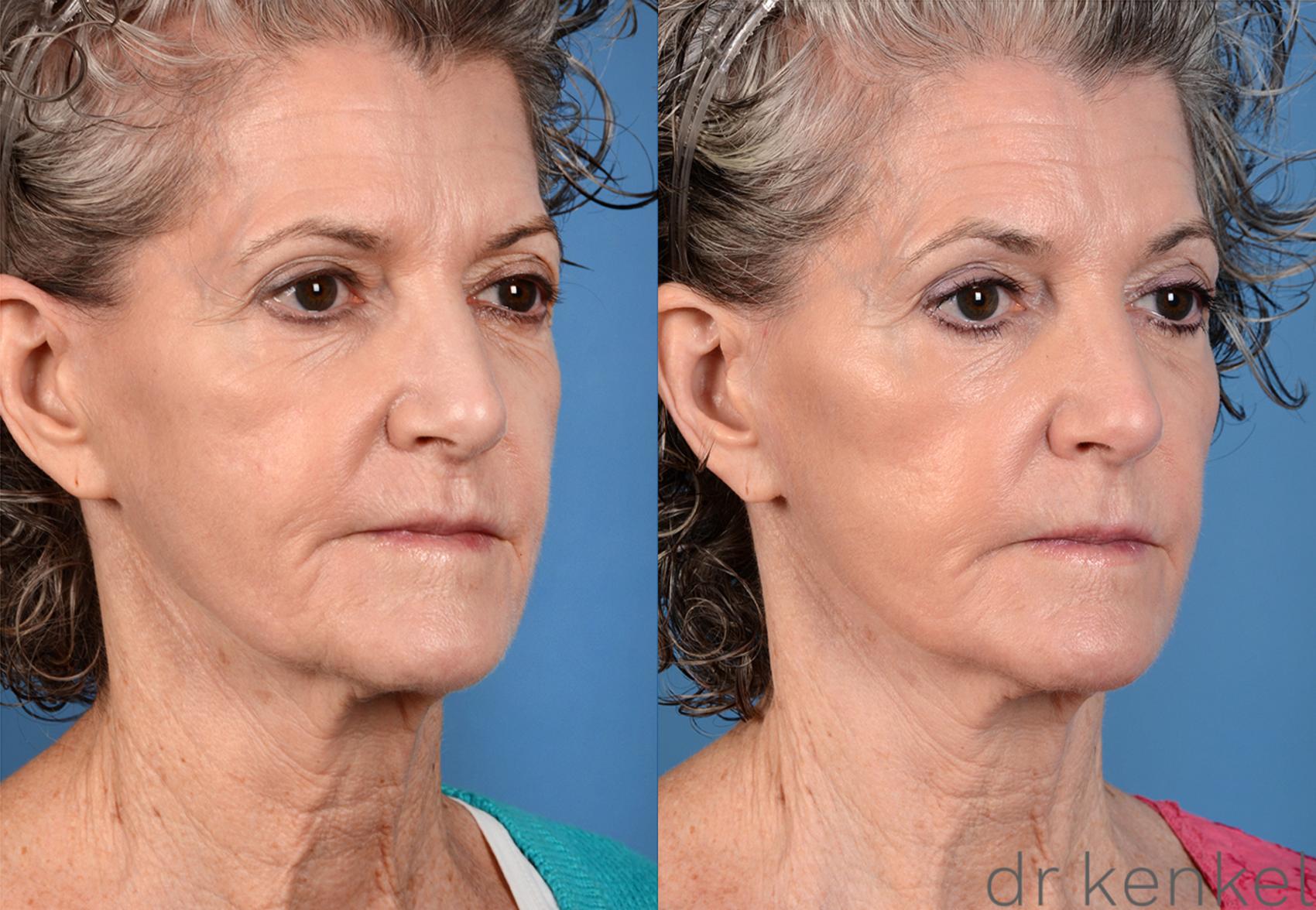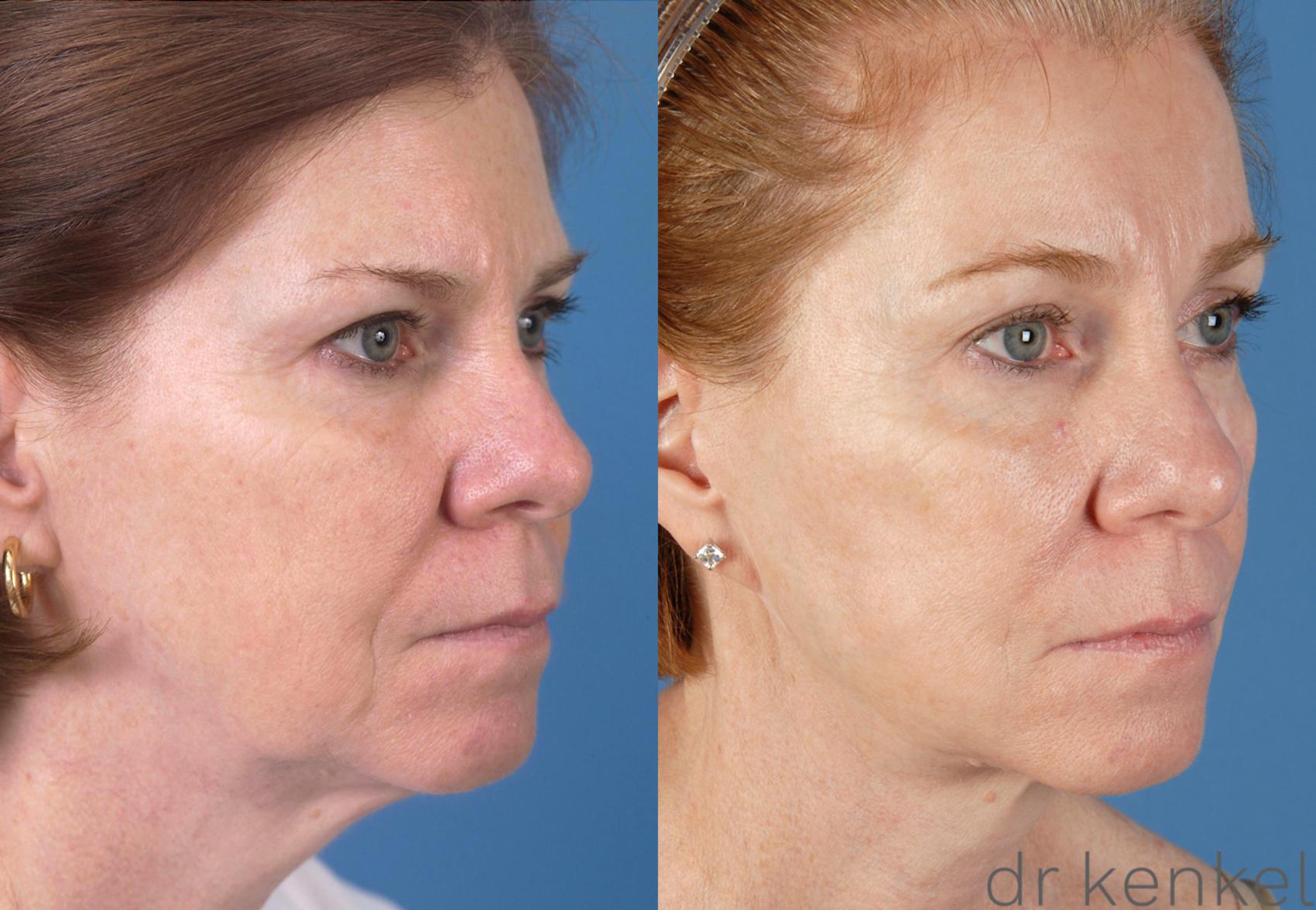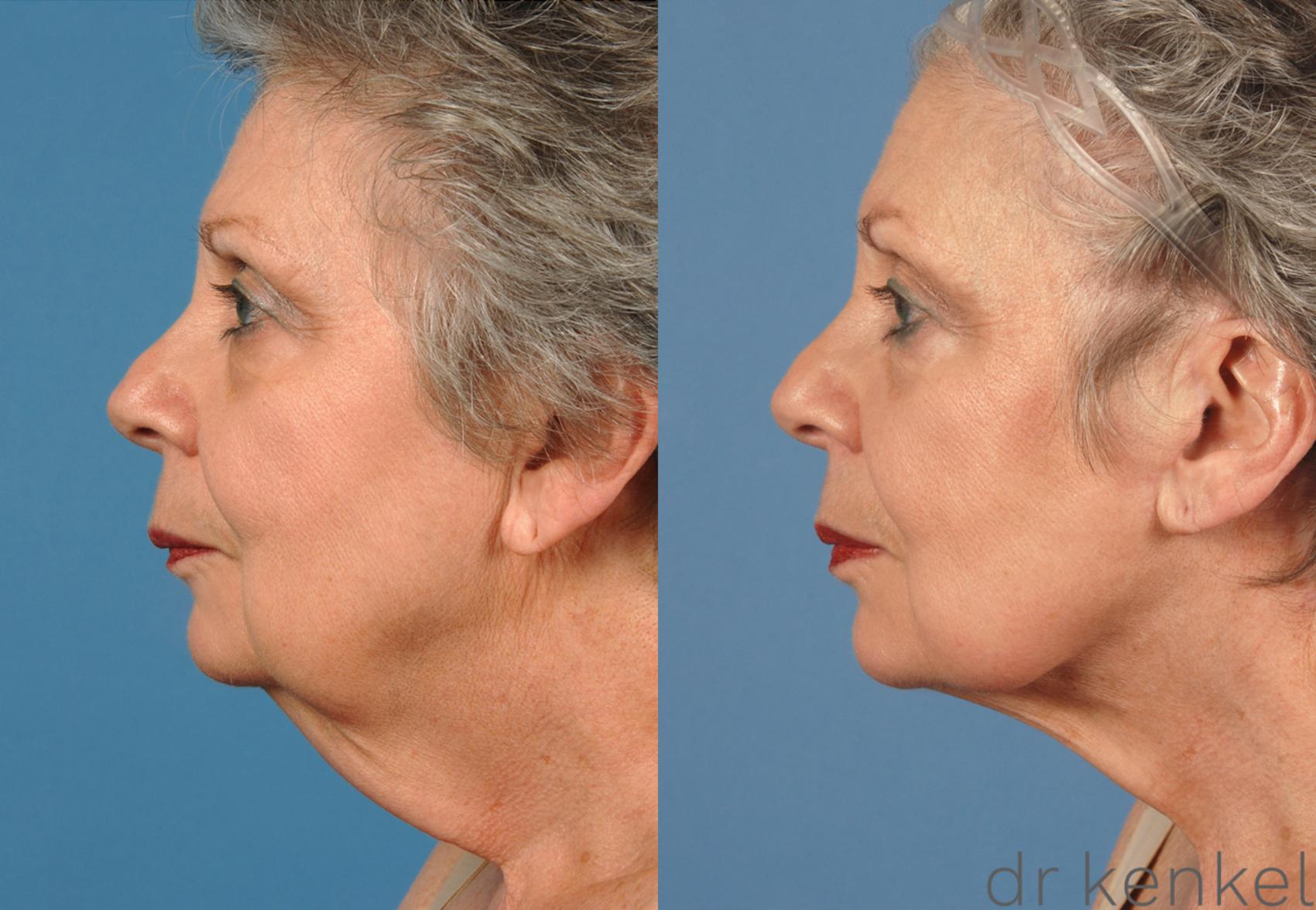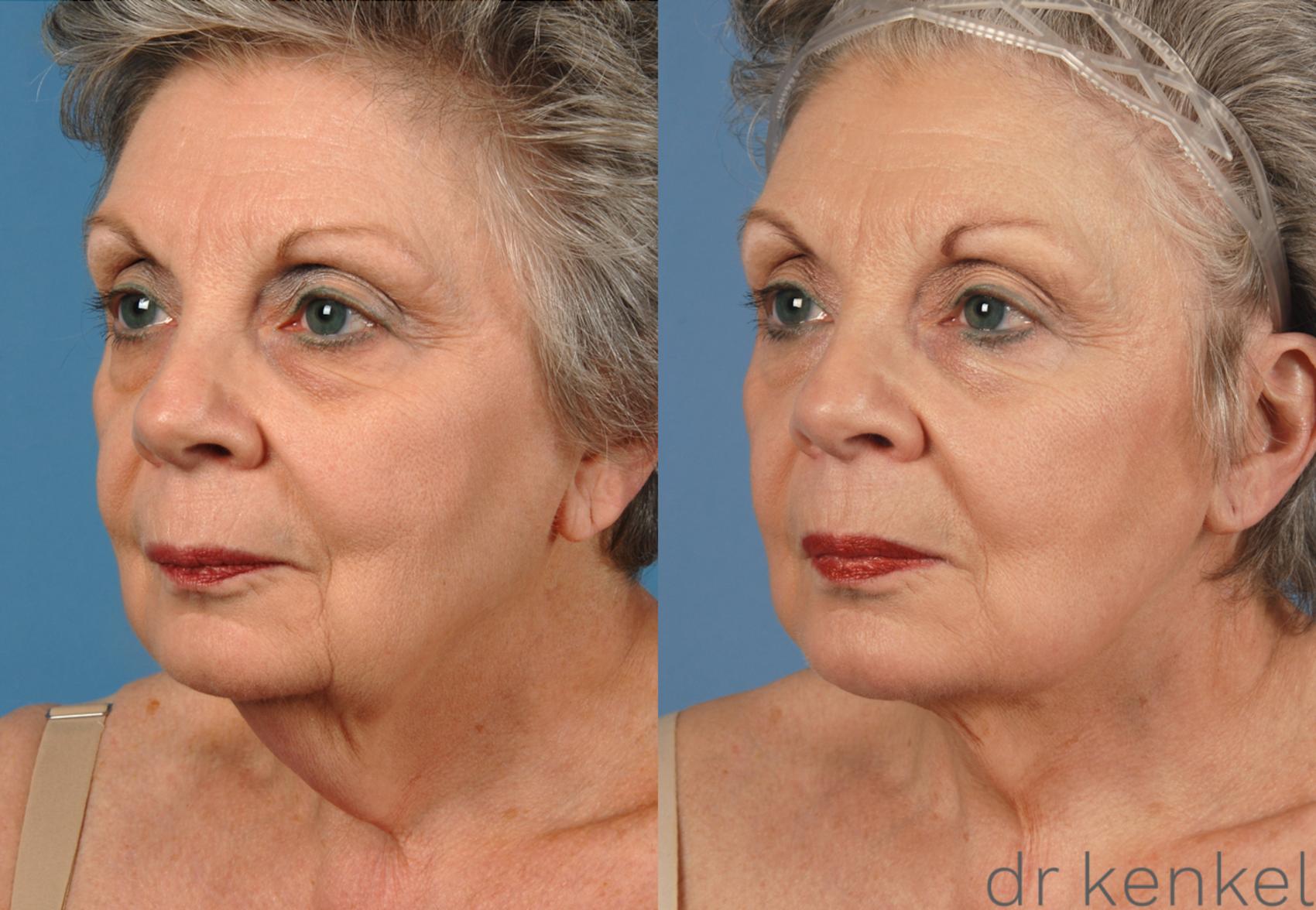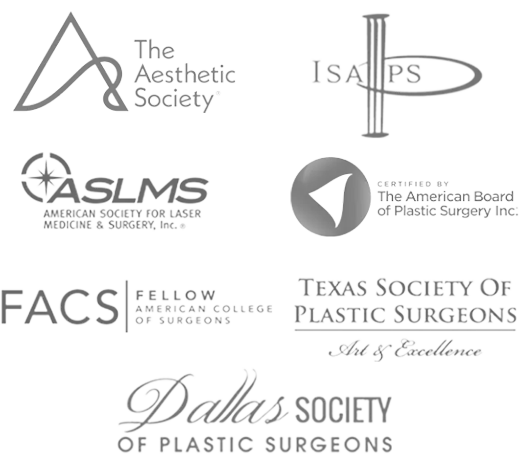Jeffrey Kenkel, MD
1801 Inwood Road, 5th Floor
Dallas, TX 75390
Phone: (214) 645-3112
Fax: (214) 645-3105
Monday – Friday : 8:30 a.m.– 5 p.m.
Jeffrey Kenkel, MD
12500 Dallas Parkway, 3rd Floor
Frisco, TX 75033
Phone: (469) 604-9120
Monday – Friday : 8 a.m.– 5 p.m.
Facelift in Dallas & Frisco
Dr. Jeffrey Kenkel is considered one of the best facelift surgeons in Dallas and Frisco, Texas. He approaches facelift surgery as a custom procedure, performed differently for each patient. The men and women who travel to consult with Dr. Kenkel about facelift surgery from Fort Worth, McKinney, Prosper, Allen, and other nearby cities are a very diverse group but share a desire to look great for their age. Instead of wanting to look like they did in their 20s or 30s, these cosmetic surgery patients want to look refreshed and energized.
Extraordinary is the best word to describe (Dr. Kenkel) and all of his team. From the moment I checked in, met everyone on his team, and checked out, my patient care was superb. Dr. Jayne Coleman, the anesthesiologist who works with Dr. Kenkel in surgery, is the best anesthesiologist I have ever had. Dr. Kenkel himself is the most accommodating doctor I have ever dealt with. Being able to get in touch with him is extremely easy, and he does everything possible to help the patient heal from any procedure.
– Healthgrades 5-Star review from laser skin rejuvenation and neck lift patient
Who is a good candidate for a facelift?
Although many prospective patients have concerns about being “too young” or “too old” for facelift surgery, it’s important to remember that we’re all individuals who age at different rates and in different ways. For example, lifestyle habits and genetics may make one person a good candidate for facelift surgery in their 40s, while another can postpone surgery until their 50s or later. Good candidates should be healthy enough to undergo anesthesia and be free of any existing medical conditions that could affect their surgeries. Read more about the right age for facelift surgery in our blog post.
Facelift surgery rejuvenates the lower two-thirds of the face, addressing a variety of concerns, including:
- Loss of definition along the jawline
- Sagging cheeks and jowls
- Double chin or a “turkey neck”
- Marionette lines, nasolabial folds, and other wrinkles around the mouth
What’s a mini facelift?
A mini facelift, also called a short scar facelift, is less invasive than a complete facelift. The incisions are limited to the front of the ear; they do not continue into the hairline at the temples. The mini facelift is best for people with good skin elasticity who have early sagging of the cheeks, jawline, and neck. People who are not ready for surgery may want to consider nonsurgical alternatives.
Can you have a facelift without surgery?
Patients who prefer a nonsurgical approach to facial rejuvenation can choose less invasive cosmetic treatments that help you look younger—without incisions and with less downtime. Nonsurgical options include:
- BOTOX® Cosmetic and other neuromodulators
- JUVÉDERM® and other dermal fillers
- Skin tightening with FaceTite and Morpheus8
- Laser skin resurfacing
Dr. Kenkel can provide facial rejuvenation without surgery by performing a personalized combination of these treatments. During your initial consultation, he will talk with you about your concerns and determine whether you are a good candidate for nonsurgical treatments or a surgical facelift.
Can you get a neck lift without a facelift?
While Dr. Kenkel combines most facelift procedures with neck lift surgery, patients whose concerns are limited to the appearance of their necks may be good candidates for a standalone neck lift or lower facelift. Nonsurgical skin tightening options such as Morpheus8 RF microneedling are available for the neck as well.
Will a facelift rejuvenate my whole face?
Keep in mind also that other complementary procedures can further enhance your facelift results. If you’re more concerned by the aging of your upper face, you may be a better candidate for eyelid surgery or brow lift. In other cases, Dr. Kenkel can combine a facelift with eyelid surgery, lip lift, injectables, or other treatment options for a full-face rejuvenation.
How much does a facelift cost in Dallas & Frisco?
Because each procedure is completely customized to your specifications, it’s not possible to offer a quote without an in-person visit. During your consultation, you’ll receive a written quote that includes all fees associated with surgery. If you decide to move forward with your procedure, we require a $500 deposit to reserve a time and date just for you.
What should I expect from my facelift consultation?
Your consultation is a comprehensive appointment during which you and Dr. Kenkel talk extensively about your lifestyle, your health history, and your goals for surgery. Dr. Kenkel also performs a physical examination of your face and neck to fully understand your concerns and help him develop an appropriate surgical plan.
After you meet with Dr. Kenkel, we’ll take a few photos of your face to save in your file. You’ll chat with Debbie, our coordinator, to discuss pricing and other logistical factors related to surgery. We understand that plastic surgery is a big decision, and we strive to make this appointment as low-pressure as possible. It is very helpful to bring photos of yourself from 10 to 15 years prior as that often helps serve as a template for your goals. You can expect to be in our office for about an hour.
How is facelift surgery performed?
Facelift surgery can be customized to meet each patient’s specific needs, but most procedures begin with incisions around the ears and into the hairline. In some cases, Dr. Kenkel often uses an incision under the chin.
Once he has made the incisions, Dr. Kenkel performs a High SMAS procedure; depending on the patient’s specifications, he may reshape, add, or remove fat. He adjusts and repositions the tissue overlying the muscles before redraping skin and trimming away any excess, ensuring it doesn’t appear overly tight. He closes the incisions with sutures and adds a small drainage tube to prevent excessive fluid buildup. By keeping tension on the underlying muscles instead of the skin, he creates long-lasting surgical results without excessive scarring. Dr. Kenkel may add fat to certain areas of your face to help restore fat loss that you may have experienced while aging.
A Passion for Facial Plastic Surgery
Jeffrey Kenkel, MD, FACSAt the apex of an accomplished career, board-certified plastic surgeon Dr. Jeffrey Kenkel is enthusiastic about turning his focus exclusively to facial plastic surgery and nonsurgical facial rejuvenation. Known for creating understated yet remarkable results, Dr. Kenkel ranks among the best plastic surgeons in the greater Dallas area.
- Chair of the Department of Plastic Surgery, UT Southwestern
- D Magazine, Best Doctors in Dallas 10+ years
- Past president, The Aesthetic Society
- Past president of Dallas Society of Plastic Surgeons
Credentials You Can Trust
What happens on the day of surgery?
You will be required to spend the night after surgery in our extended care unit for plastic surgery patients. It is a hotel-like environment that offers 24-hour nursing care for our patients. Dr. Kenkel advises you in advance so that you may plan accordingly. Facelift surgery often requires general anesthesia, which is carefully administered by a board-certified anesthesiologist. Our pre-op facelift document details how you can adequately prepare your home and body for surgery.
What can I expect after a facelift?
Dr. Kenkel recognizes that every patient handles discomfort differently. He prescribes pain medication to help manage symptoms after surgery, but many patients find they don’t need to use it for more than a few days. Numbness in your cheeks and near your incisions is common and takes some time to resolve fully.
Although staying mobile after surgery is important, don’t strain yourself. Light walks around the house are a good way to promote circulation and help facilitate healing. It’s important to have supportive friends or family members who can help you around the house with errands until you’re able to do them yourself. It’s also helpful to avoid eating foods high in salt, as they can exacerbate swelling.
Swelling and bruising are typical, and you may look worse than you feel for a couple of weeks. These symptoms may be more prominent on one side of your face than the other and may vary in severity from day to day. These are normal variables in the healing process. Dr. Kenkel encourages patients to reach out to his office during recuperation because it can be an emotional time for many patients.
How long is recovery from facelift surgery?
After facelift surgery, patients are typically ready to resume normal daily activities, return to work, and go out in public within about 2 weeks. Camouflage makeup may be applied at this point to cover any remaining bruising.
Recovery Timeline
While patient experiences vary, here is a general timeline for recovery milestones:
- Stay in hospital: 1 night
- Drains removed: 3 to 4 days
- Keep upper body elevated: 7 days
- Sutures removed: 6 to 7 days
- Wear chin compression strap: continuously for 7 to 10 days, then at night for 7 days
- Limit salt intake (minimize swelling): 4 to 6 weeks
- Ready to go in public: 2 to 3 weeks
- Resume strenuous workouts: 6 to 8 weeks
- Numbness in surgical areas fades: 3 to 4 months
Be sure to follow Dr. Kenkel’s specific recovery instructions closely. If you have any questions, contact our office at (214) 645-3112. For details about what to expect the first 2 weeks after surgery, see this blog post.
How long will I need to wear the chin strap after facelift surgery?
For the first week after surgery, it’s important to wear the chin compression strap as much as possible to minimize swelling. During the second week, wear it when you are sleeping for extra support.
Facelift FAQ
Q: What’s the best age for facelift surgery?
A: The aging process affects people differently, so there is no “best” age for a facelift. Patients are typically in their 50s and 60s; however, Dr. Kenkel has also had patients in their 40s and 70s.
Q: Will a facelift address my jowls?
A: Yes. A facelift can get rid of jowls by lifting and tightening the cheeks.
Q: Is it really OK to combine procedures like a brow lift and a facelift?
A: Combining procedures is safe for most healthy patients. Because facelift surgery does not improve the entire face, combining it with other procedures, such as a brow lift and eyelid surgery, can help the whole face look younger.
Q: How painful is a full facelift?
A: While experiences vary, most patients take their prescribed pain medication for just a few days, if at all. Tightness and numbness are normal sensations that typically fade; pain is rare.
Q: How many visits do I have after facelift surgery?
A: You’ll return to our office within 4 days after surgery for drain removal, if applicable. In 7 to 10 days, you’ll return for scheduled suture removal. During these visits, you’ll discuss your results and concerns with Dr. Kenkel. He often sees you weekly for ultrasound treatments to help resolve your swelling.
Q: How many years younger will I look after I recover?
A: Facelift patients typically look 8 to 10 years younger, like a refreshed version of themselves.
Q: How long do facelift results last?
A: In general, the results of facelift surgery can last for a decade, especially with proper follow-up care and healthy lifestyle habits. When you notice the signs of aging gradually beginning to return, you may choose to maintain your results with nonsurgical treatments, such as injectable fillers or even a revisionary procedure.
Q: Should I plan to get regular BOTOX injections after facelift surgery?
A: BOTOX and facelifts are used for different areas of the face. BOTOX smooths out lines and creases in the upper face, including the forehead and around the eyes, while a facelift improves the mid to lower face. You may not need BOTOX after your facelift. If you are unsure, ask Dr. Kenkel.
Q: Can you see facelift scars?
A: Dr. Kenkel takes care to make facelift incisions as discreetly as possible, leading to scars that aren’t noticeable to most people. However, they can take several months to fade completely. It’s important to follow your post-op guidelines and avoid unprotected sun exposure. Your skin may feel dry or rough throughout the healing process. This can be minimized with good skincare habits.
Request a Consultation
If you’d like to look like yourself, only younger, Dr. Kenkel and his caring staff can help you realize your aesthetic goals. Request a consultation online or call us at (214) 645-3112.




